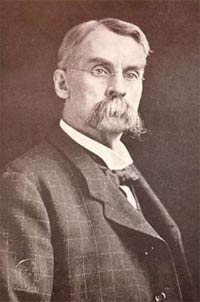
James Tyler Kent
(1849-1916)
Dr. Kent was born in Woodhul, New York. He graduated from the Eclectic Medical Institute of Cincinnati, and started practice in St. Louis as an Eclectic. He became interested in homoeopathy in 1878, when his wife's illness failed to respond either to eclectic or allopathic treatment and was cured by a homoeopath. Kent began practice with low potencies, but he was not satisfied. Later he resolved to test the 30th potency to see if there was any medicine present. He prepared with his own hands the 30th potency of Podophyllum according to Centesimal scale after the method of Hahnemann.
One day a child was brought in to his clinic in emergency and it appeared that the child would not live long. While it lay in the arms of its mother, a thin yellow fecal stool ran all over his carpet. The odor was like that of the Podophyllum stool. It was horribly offensive, and the stool was so copious that the mother made the remark that she did not know where it all came from. Dr. Kent thought to test Podophyllum 30 prepared by him for that case. Next morning he was surprised to learn from the grandmother of the child that he was doing well. One dose of Podophyllum cured a dangerously ill patient. He then realized the power of the potentized remedies, and he thought of using increasingly potentized remedies in his practice.

He became famous as a high potency homoeopath, as most of the homoeopaths before him were using low potency remedies. He advocated the use of the 30th, 200th, 1M, 50M, CM, DM and MM potencies made on the Centesimal scale. Dr. Kent introduced the doctrine of 'Series in Degrees' in the treatment of chronic diseases. He found that one potency was not sufficient for chronic cases, though it would generally do for acute illnesses. Many chronic illnesses were cured by keeping the patient under the influence of the one indicated remedy for two or more years. But this cannot be done with continuous curative action, unless the doctrine of 'Series in Degrees' is fully understood and used.
Dr. Kent discovered that "just as there are octaves of musical tones, so there are octaves in the simple substance, through which severally it is possible to correspond with the various planes of the interior organism of the animal cells." These planes correspond to the similar remedy in 30th, 200th, 1M 10M 50M, CM, DM, and MM potencies. He found that when the action of the 30th is completed the patient needs the 200th potency, but when the action of 200th potency is exhausted, the patient requires the 1M potency; and so on till the same remedy in higher and highest potencies cures permanently.

Dr. Kent also discovered the 'Law of Vital Action and Reaction' as pointed out by Dr. Hahnemann. "A medicine is not too high to cure so long as it is capable of aggravating the symptoms belonging to the sickness; in the first hours in acute, and in the first few days of a chronic sickness." He also thought that a homoeopathic aggravation was essential from the application of the Simillimum in chronic cases. Dr. Kent felt that if there was relief without homoeopathic aggravation, the chronic sickness was only superficially affected and would require a deeper acting remedy to remove the vital disorder.
Dr. Kent laid greatest importance to the will, understanding and memory of the patient. They form the innermost of the man, and are extended outward through the general physical organism. Cure takes place from center to periphery, but if the symptoms retreat from periphery to center the prescription is wrong and must be antidoted. Hence in order to treat successfully, the homoeopath should know the correspondence of organs and direction of cure.

Dr. Kent proved many new medicines, which he described in his book: 'New Remedies, Clinical Cases, Lesser Writings, Aphorisms and Precepts'.
Dr. Kent was famous for teaching Materia Medica. He taught Materia Medica at the Homoeopathic Medical College of St. Louis, from 1881-88, at the School of Homoeopathy, Philadelphia from 1890-99, at Hahnemann Medical College and Hospital, Chicago from 1903-9, and Hering Medical College Hospital.
Students from England, European countries, India and other parts of the world sought admission to the institution where he taught the subject. Sir John Weir, A.H. Grimmer, Pierre Schmidt, B.K. Bose, and other famous homoeopaths from all over the world were his disciples. He was the President and Trustee of Chicago Homoeopathic Hospital.
Books by James Tyler Kent
- Lectures on Homeopathic Philosophy
- Lectures on Materia Medica
- New Remedies, Clinical Cases, Lesser Writings
- Repertory of the Homeopathic Materia Medica
- Use of the Repertory
- What the Doctor Needs to Know